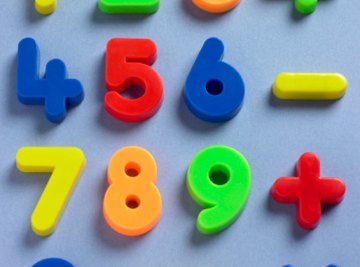
Elementary math curricula often include a discussion of number properties, specifically the properties of addition and subtraction. The properties of addition and subtraction make it easier to work with numbers by allowing you to regroup them so that an equation is easier to solve. Understanding the properties of addition and subtraction can help you to work with numbers more effectively.
Commutative Property
The commutative property says that the positions of the numbers in a mathematical equation do not affect the ultimate solution. Five plus three is the same as three plus five. This applies to addition, regardless of how many numbers you add together. The commutative property allows you to add a large group of numbers together in any order. The commutative property does not apply to subtraction. Five minus three is not the same as three minus five.
Associative Property
The associative property applies to more complicated equations that use parentheses or brackets to separate groups of numbers. The associative property says that numbers you are adding together can be grouped in any order. When you are adding numbers together, you can move the parentheses around. For example, (3 + 4) + 2 = 3 + (4 + 2). The associative property also does not apply to subtraction since (3 - 4) - 2 does not equal 3 - (4 - 2). This means that if you are working on a subtraction equation, you cannot move the brackets around.
Identity Property
The identity property says that any number plus zero equals itself. For example, 3 + 0 = 3. The identity property also applies to subtraction since 3 - 0 = 3. Zero is known as the identity number because in addition and subtraction it does not affect other numbers. When a child is adding or subtracting large groups of numbers, remind her that the number zero does not affect other numbers in the equation.
Inverse Operations
In addition to the properties that affect addition and subtraction separately, addition and subtraction also relate to each other. They are inverse operations, which is similar to saying that addition and subtraction are opposites. For example, five plus three minus three equals five because adding and then subtracting the threes cancels both of them out. Encourage your child to look for numbers that cancel each other out when he is adding and subtracting groups of numbers.
References
About the Author
Stacy Zogheib's writing has been published in various online publications. She is a teacher and developmental specialist with experience teaching first grade, special education and working with children ages 0 to 3. She has a Bachelor of Arts in elementary and special education from Wittenberg University in Springfield, Ohio and a Master's degree in Early Childhood Education from Northern Arizona University.
Photo Credits
BananaStock/BananaStock/Getty Images
